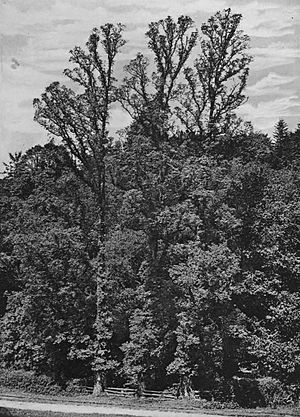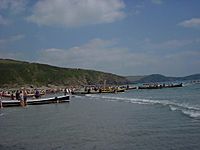Ulmus minor 'Stricta' facts for kids
Quick facts for kids Ulmus minor 'Stricta' |
|
|---|---|

U. minor 'Stricta', Coldrenick, Cornwall, before 1913
|
|
| Species | Ulmus minor |
| Cultivar | 'Stricta' |
| Origin | England |
The Cornish elm (scientific name: Ulmus minor 'Stricta) is a special type of field elm. A cultivar is a plant that has been grown and selected by people for certain features. This tree was very common in South West England (especially Cornwall and West Devon) and Brittany in France.
However, a serious illness called Dutch elm disease arrived in the late 1960s. This disease sadly caused most of these trees to die. Scientists are still discussing where the Cornish elm first came from in England. Some think it came from Brittany. Others believe it might have survived the Ice Ages on land that is now under the sea south of Cornwall.
Today, most mature Cornish elm trees are found in Australia. They were brought there in the 1800s. Scientists have studied the DNA of the 'Stricta' elm. They found out that all Cornish elms are actually clones. This means they are all genetically identical copies of one original tree.
Contents
What Does the Cornish Elm Look Like?
The Cornish elm is a tall, thin tree that loses its leaves in winter (it's a deciduous tree). It can grow up to 27 meters (89 feet) tall in protected places. In windy areas, it's usually half that size.
Its main features are:
- A long, straight trunk.
- A narrow, fan-shaped top (crown).
- Short, straight branches that grow upwards.
The leaves are small, about 6 cm (2.4 inches) long and 3.5 cm (1.4 inches) wide. They are dark green, shiny, and smooth on top. They are shaped like an oval or an egg, wider at the top. The tip of the leaf often comes to a sharp point (called acuminate).
The flowers are tiny and grow in groups of 15 to 20. They don't have petals and are pollinated by the wind. The fruits are called samarae. These are small, flat, winged seeds. In England, the fruits rarely ripen. When they do, they look like other field elm fruits. They are usually oval-shaped, about 16 mm (0.6 inches) long.
Sometimes, Cornish elms with wider, more spreading tops are seen around Truro and on the Lizard Peninsula in Cornwall. These are sometimes called 'Lizard Elm'.
-
Cornish elm in Preston Park, Brighton, 2005
-
Short-shoot leaves of Cornish elm, Calton Hill Park, Edinburgh
Diseases and How They Spread
The Cornish elm is very easily affected by Dutch elm disease. This disease is caused by a fungus spread by bark beetles. When a tree gets sick, it usually dies.
However, the Cornish elm often grows new shoots from its roots, called "suckers." These suckers can grow into small trees or bushes. Because of these suckers, the Cornish elm's genes are not considered to be in danger of disappearing completely. Like other field elms, new Cornish elm trees mostly grow from these suckers.
Uses and Where They Grow
For a long time, the Cornish elm was thought to be the best tree to plant along the coast of Cornwall. It helped protect against strong winds. Its wood was very strong and valuable. People used it to build wheels and wagons.
Traditional Cornish pilot gig boats were also made from Cornish elm. The rules for gig races even said the boats had to be made from "Cornish narrow-leaved elm." In the early 1900s, the Cornish elm was very common in West Cornwall and Brittany. It was also planted as a pretty tree in parts of southern England and southern Ireland.
Today, very few old Cornish elms are left in the wild in England. Only one is known in Cornwall. About 18 are thought to be in the Brighton area. Two more were found in East Sussex in 2009. In Edinburgh, Scotland, two specimens still survive from 2019.
Sometimes, another type of elm called the Wheatley or Guernsey elm was mistakenly called "Cornish elm." This happened a lot when local councils planted trees in the UK. The Cornish elm was also brought to the United States in the 1860s.
You can't easily buy Cornish elm trees from nurseries anymore, except in Australia.
Special Trees Still Standing
The Great Elm of Rosuic was a very old, large elm tree. It had a trunk over 2.5 meters (8.2 feet) wide before it got sick. Even though the main tree died, it still produces suckers from its roots.
As of 2011, the Woodland Trust says there is only one confirmed mature Cornish elm left in Cornwall. It's near Helston and its trunk is 1.89 meters (6.2 feet) around. A few old trees also survive in Castletownbere Cemetery in County Cork, Ireland.
Old Cornish elms, which spread out as they age, can be seen by St Stephen's Anglican Church in Mittagong, New South Wales, Australia.
-
Old Cornish elms (right), Mittagong, NSW (2018)
Similar Elm Types
There are some other elm trees that look similar to the Cornish elm or were once thought to be related.
- An Ulmus stricta parvifolia was described in 1829. It had smaller leaves than the Cornish elm.
- Goodyer's elm was considered a type of Cornish elm by some experts.
- Some nurseries listed 'Dickson's Golden Elm' as a form of Cornish elm.
Hybrid Elms
Some elm trees are thought to be natural mixes (hybrids) of the Cornish elm with other types of elms. For example, the cultivar 'Daveyi' and 'Exoniensis' might be a mix of Wych elm and Cornish elm. The botanist F. J. Fontaine thought that the tree called Ulmus 'Purpurea' might also be related to the Cornish elm.
'Stricta'-like Elms from Späth Nursery
In the late 1800s and early 1900s, a nursery in Berlin called Späth sold a tree they called U. campestris cornubiensis. However, experts like Augustine Henry said this tree was different from the true Cornish elm. Its leaves looked more like a common type of U. nitens (which is another name for U. minor).
One of these trees from Späth's nursery was sent to the Dominion Arboretum in Ottawa, Canada, in 1897. Three more went to the Royal Botanic Garden Edinburgh in 1902. One of these trees still survives in Edinburgh today (as of 2016). It is about 25 meters (82 feet) tall.
-
Späth's U. campestris cornubiensis, Royal Botanic Garden Edinburgh
Cornish Elm in Art
The Cornish elm has appeared in paintings. For example, Holman Hunt's watercolor Helston, Cornwall (1860) shows elm trees in hedgerows. Another watercolor, Egloshayle, Cornwall by Thomas Campbell-Bennett, shows Cornish elms next to the River Camel. This painting shows how the Cornish elm often has a flat, wind-cut top in its natural home.
Where You Can Find Them (Collections)
Here are some places where Cornish elm trees are kept in collections:
- North America
- Arnold Arboretum, US.
- Bartlett Tree Nurseries, US.
- J. C. Raulston Arboretum, North Carolina State University, US.
- Europe
- Brighton & Hove City Council, UK. (Part of the NCCPG Elm Collection).
- Cambridge Botanic Garden, University of Cambridge, UK.
- Grange Farm Arboretum, Sutton St James, Spalding, Lincolnshire, UK.
- Wijdemeren City Council, Netherlands.
- Australasia
- Royal Botanic Gardens, Sydney, Australia.
Nurseries That Sell Them
- Australasia
- Established Tree Transplanters Pty. Ltd., Wandin, Victoria, Australia.















